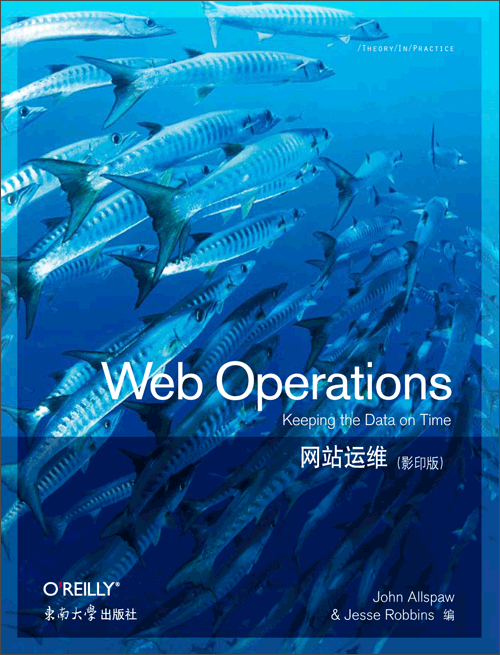网站运维(影印版)
John Allspaw, Jesse Robbins 编
出版时间:2011年03月
页数:336
“网络正在改变我们的生活方式并触及每一个人。而越来越依赖于网络的同时,人们也越来越依赖于我们。所以网站运维是至关重要的工作。”
——来自序言
网络应用牵涉到很多专业人士,而网站运维人员必须确保应用的每一部分在其整个生命周期中都能正常工作。当初创公司遭遇了未曾预期的访问流量尖峰,或者当某个新特性导致成熟应用失效时,你就需要这样的专业知识。在这部文章和访谈集中,网站运维老手Theo Schlossnagle、Baron Schwartz和Alistair Croll向这个日新月异的领域提供了他们的真知灼见。你还将学到如何使网站蓬勃发展的秘诀,这是来自最大规模网站建设者的第一手资料。
· 学习网站运维技能,了解这些技巧来自于经验而非学校教育的原因
· 理解为何从应用程序和基础设施收集统计数据都很重要
· 为数据库架构和规模日益增长带来的隐患考虑通用的处理方法
· 学习如何处理宕机和降级相关的人为因素
· 找到在蜂拥而至的巨大流量后避免灾难的方法
· 问题发生后了解症结所在,防止其再次发生
——来自序言
网络应用牵涉到很多专业人士,而网站运维人员必须确保应用的每一部分在其整个生命周期中都能正常工作。当初创公司遭遇了未曾预期的访问流量尖峰,或者当某个新特性导致成熟应用失效时,你就需要这样的专业知识。在这部文章和访谈集中,网站运维老手Theo Schlossnagle、Baron Schwartz和Alistair Croll向这个日新月异的领域提供了他们的真知灼见。你还将学到如何使网站蓬勃发展的秘诀,这是来自最大规模网站建设者的第一手资料。
· 学习网站运维技能,了解这些技巧来自于经验而非学校教育的原因
· 理解为何从应用程序和基础设施收集统计数据都很重要
· 为数据库架构和规模日益增长带来的隐患考虑通用的处理方法
· 学习如何处理宕机和降级相关的人为因素
· 找到在蜂拥而至的巨大流量后避免灾难的方法
· 问题发生后了解症结所在,防止其再次发生
- Foreword
- Preface
- 1 Web Operations: The Career
- Theo Schlossnagle
- Why Does Web Operations Have It Tough?
- From Apprentice to Master
- Conclusion
- 2 How Picnik Uses Cloud Computing: Lessons Learned
- Justin Huff
- Where the Cloud Fits (and Why!)
- Where the Cloud Doesn’t Fit (for Picnik)
- Conclusion
- 3 Infrastructure and Application Metrics
- John Allspaw, with Matt Massie
- Time Resolution and Retention Concerns
- Locality of Metrics Collection and Storage
- Layers of Metrics
- Providing Context for Anomaly Detection and Alerts
- Log Lines Are Metrics, Too
- Correlation with Change Management and Incident Timelines
- Making Metrics Available to Your Alerting Mechanisms
- Using Metrics to Guide Load-Feedback Mechanisms
- A Metrics Collection System, Illustrated: Ganglia
- Conclusion
- 4 Continuous Deployment
- Eric Ries
- Small Batches Mean Faster Feedback
- Small Batches Mean Problems Are Instantly Localized
- Small Batches Reduce Risk
- Small Batches Reduce Overhead
- The Quality Defenders’ Lament
- Getting Started
- Continuous Deployment Is for Mission-Critical
- Applications
- Conclusion
- 5 Infrastructure As Code
- Adam Jacob
- Service-Oriented Architecture
- Conclusion
- 6 Monitoring
- Patrick Debois
- Story: “The Start of a Journey”
- Step 1: Understand What You Are Monitoring
- Step 2: Understand Normal Behavior
- Step 3: Be Prepared and Learn
- Conclusion
- 7 How Complex Systems Fail
- John Allspaw and Richard Cook
- How Complex Systems Fail
- Further Reading
- 8 Community Management and Web Operations
- Heather Champ and John Allspaw
- 9 Dealing with Unexpected Traffic Spikes
- Brian Moon
- How It All Started
- Alarms Abound
- Putting Out the Fire
- Surviving the Weekend
- Preparing for the Future
- CDN to the Rescue
- Proxy Servers
- Corralling the Stampede
- Streamlining the Codebase
- How Do We Know It Works?
- The Real Test
- Lessons Learned
- Improvements Since Then
- 10 Dev and Ops Collaboration and Cooperation
- Paul Hammond
- Deployment
- Shared, Open Infrastructure
- Trust
- On-call Developers
- Avoiding Blame
- Conclusion
- 11 How Your Visitors Feel: User-Facing Metrics
- Alistair Croll and Sean Power
- Why Collect User-Facing Metrics?
- What Makes a Site Slow?
- Measuring Delay
- Building an SLA
- Visitor Outcomes: Analytics
- Other Metrics Marketing Cares About
- How User Experience Affects Web Ops
- The Future of Web Monitoring
- Conclusion
- 12 Relational Database Strategy and Tactics for the Web
- Baron Schwartz
- Requirements for Web Databases
- How Typical Web Databases Grow
- The Yearning for a Cluster
- Database Strategy
- Database Tactics
- Conclusion
- 13 How to Make Failure Beautiful: The Art and
- Science of Postmortems
- Jake Loomis
- The Worst Postmortem
- What Is a Postmortem?
- When to Conduct a Postmortem
- Who to Invite to a Postmortem
- Running a Postmortem
- Postmortem Follow-Up
- Conclusion
- 14 Storage
- Anoop Nagwani
- Data Asset Inventory
- Data Protection
- Capacity Planning
- Storage Sizing
- Operations
- Conclusion
- 15 Nonrelational Databases
- Eric Florenzano
- NoSQL Database Overview
- Some Systems in Detail
- Conclusion
- 16 Agile Infrastructure
- Andrew Clay Shafer
- Agile Infrastructure
- So, What’s the Problem?
- Communities of Interest and Practice
- Trading Zones and Apologies
- Conclusion
- 17 Things That Go Bump in the Night (and How to
- Sleep Through Them)
- Mike Christian
- Definitions
- How Many 9s?
- Impact Duration Versus Incident Duration
- Datacenter Footprint
- Gradual Failures
- Trust Nobody
- Failover Testing
- Monitoring and History of Patterns
- Getting a Good Night’s Sleep
- Contributors
- Index
书名:网站运维(影印版)
作者:John Allspaw, Jesse Robbins 编
国内出版社:东南大学出版社
出版时间:2011年03月
页数:336
书号:978-7-5641-2502-8
原版书书名:Web Operations
原版书出版商:O'Reilly Media
购买选项
